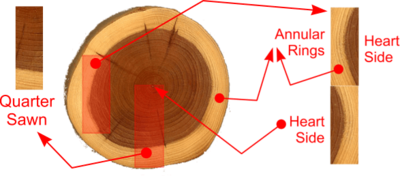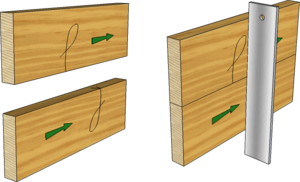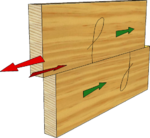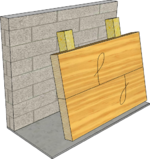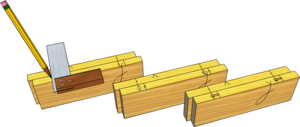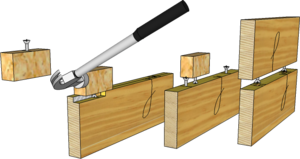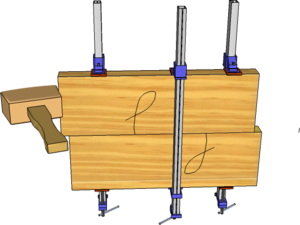Widening Joint: Difference between revisions
From DT Online
mNo edit summary |
mNo edit summary |
||
| Line 6: | Line 6: | ||
To avoid this problem almost completely, choose boards which have been sliced from across the centre of the tree and whose [https://en.wikipedia.org/wiki/Dendrochronology#Growth_rings '''Annular Rings'''] are therefore close to being at right angles to each face ''(these boards are known as [https://en.wikipedia.org/wiki/Quarter_sawing '''Quarter Sawn'''] - they are much sought-after and will be hard to find!)'' | To avoid this problem almost completely, choose boards which have been sliced from across the centre of the tree, and whose [https://en.wikipedia.org/wiki/Dendrochronology#Growth_rings '''Annular Rings'''] are therefore close to being at right angles to each face ''(these boards are known as [https://en.wikipedia.org/wiki/Quarter_sawing '''Quarter Sawn'''] - they are much sought-after and will be hard to find!)'' | ||
[[File:WideningJointTesting.png|300px|right]] | [[File:WideningJointTesting.png|300px|right]] | ||
It is important to ensure joining surfaces are straight and '''[[Squareness|square]]''' and to arrange boards such that their grains go in the same direction - this so any subsequent planing and finishing is made easier. Check for '''[[Squareness]]''' by balancing one board | It is important to ensure joining surfaces are straight and '''[[Squareness|square]]''' and to arrange boards such that their grains go in the same direction - this is so any subsequent planing and finishing is made easier. Check for '''[[Squareness]]''' by balancing one board on top of another and testing with a straight edge. | ||
Some '''[[Planes|planing]]''' will be needed after jointing to ensure the finished boards surfaces are flat so choose boards somewhat thicker than the required finished size to start with. | Some '''[[Planes|planing]]''' will be needed after jointing to ensure the finished boards surfaces are flat, so choose boards somewhat thicker than the required finished size to start with. | ||
| Line 26: | Line 26: | ||
* Prepare the joining edges carefully by '''[[Planes|planing]]''' them to ensure they are straight and test for '''[[Squareness]]''' with a '''[[Try Square]]'''. | * Prepare the joining edges carefully by '''[[Planes|planing]]''' them to ensure they are straight and test for '''[[Squareness]]''' with a '''[[Try Square]]'''. | ||
* Mark '''[[Face Side and Face Edge]]''' - and if several boards are to be joined, mark the joining faces and number them to ensure they are assembled correctly. | * Mark '''[[Face Side and Face Edge]]''' - and if several boards are to be joined, mark the joining faces and number them to ensure they are assembled correctly. | ||
* Coat the joining edges with a suitable '''[[Glues and Pastes| | * Coat the joining edges with a suitable '''[[Glues and Pastes|Adhesive]]''' ''(e.g. [https://en.wikipedia.org/wiki/Polyvinyl_acetate P.V.A.])'' then '''rub''' the joining edges together to remove any air bubbles and surplus glue ''(hence the name: '''Rubbed Joint''')''. | ||
* The assembled joint can then be stacked against a wall until the glue sets as shown. | * The assembled joint can then be stacked against a wall until the glue sets as shown. | ||
* Alternatively, the boards can be held in '''[[Sash Cramp|Sash Cramps]]''' but ensure the '''[[Sash Cramp|Cramps]]''' are placed on alternative sides to prevent the boards buckling under pressure. | * Alternatively, the boards can be held in '''[[Sash Cramp|Sash Cramps]]''' but ensure the '''[[Sash Cramp|Cramps]]''' are placed on alternative sides to prevent the boards buckling under pressure. | ||
| Line 35: | Line 35: | ||
Screws can be used in this way to reinforce an ordinary '''Rubbed Joint''' with the advantage that the finished board can be worked on straight away after jointing. | Screws can be used in this way to reinforce an ordinary '''Rubbed Joint''' with the advantage that the finished board can be worked on straight away after jointing. | ||
It is also useful for joining together greasy, old, painted or rough timber in coarse construction work ''(e.g. for outside use)''. | |||
[[File:WideningJointSlotScrewedSlots.png|300px|right]] | [[File:WideningJointSlotScrewedSlots.png|300px|right]] | ||
[[File:WideningJointSlotScrewedScrews.png|300px|right]] | [[File:WideningJointSlotScrewedScrews.png|300px|right]] | ||
[[File:WideningJointSlotScrewedCramping.png|300px|right]] | [[File:WideningJointSlotScrewedCramping.png|300px|right]] | ||
* Prepare the joining edges, '''[[Gauges|Gauge]]''' their centres, then hold them together with ends overlapping about 12mm as shown. | * Prepare the joining edges, '''[[Gauges|Gauge]]''' their centres, then hold them together with ends overlapping about 12mm as shown. | ||
* Use a '''[[Try Square]]''' to '''[[Squareness|square]]''' lines across where the screws are to be positioned. | * Use a '''[[Try Square]]''' to '''[[Squareness|square]]''' lines across where the screws are to be positioned. | ||
| Line 50: | Line 53: | ||
* Bring the two pieces together and lightly '''[[Sash Cramp|cramp]]''', then using a '''[[Mallets|Mallet]]''', drive the screws along the slots to bring the timber ends together. | * Bring the two pieces together and lightly '''[[Sash Cramp|cramp]]''', then using a '''[[Mallets|Mallet]]''', drive the screws along the slots to bring the timber ends together. | ||
* if required after this ''dry run'', take apart the joint, add glue and re-assemble. | * if required after this ''dry run'', take apart the joint, add glue and re-assemble. | ||
[[Category:Wood Joints]] | [[Category:Wood Joints]] | ||
Revision as of 17:33, 5 February 2016
Widening Joints are used to make wider boards by joining narrower ones edge to edge. Whichever jointing method is chosen, care should be taken to ensure the curve of the Annular Rings is reversed on adjacent boards as shown.
As timber dries out, its Annular Rings will tend to try and straighten. Reversing their direction in this way minimises the degree to which the widened board will cup or warp.
To avoid this problem almost completely, choose boards which have been sliced from across the centre of the tree, and whose Annular Rings are therefore close to being at right angles to each face (these boards are known as Quarter Sawn - they are much sought-after and will be hard to find!)
It is important to ensure joining surfaces are straight and square and to arrange boards such that their grains go in the same direction - this is so any subsequent planing and finishing is made easier. Check for Squareness by balancing one board on top of another and testing with a straight edge.
Some planing will be needed after jointing to ensure the finished boards surfaces are flat, so choose boards somewhat thicker than the required finished size to start with.
Rubbed Joint
This plain Butt Joint is the simplest Widening Joint but with careful preparation and modern Adhesives can be very strong.
- Prepare the joining edges carefully by planing them to ensure they are straight and test for Squareness with a Try Square.
- Mark Face Side and Face Edge - and if several boards are to be joined, mark the joining faces and number them to ensure they are assembled correctly.
- Coat the joining edges with a suitable Adhesive (e.g. P.V.A.) then rub the joining edges together to remove any air bubbles and surplus glue (hence the name: Rubbed Joint).
- The assembled joint can then be stacked against a wall until the glue sets as shown.
- Alternatively, the boards can be held in Sash Cramps but ensure the Cramps are placed on alternative sides to prevent the boards buckling under pressure.
Slot Screwed Widening Joint
Screws can be used in this way to reinforce an ordinary Rubbed Joint with the advantage that the finished board can be worked on straight away after jointing.
It is also useful for joining together greasy, old, painted or rough timber in coarse construction work (e.g. for outside use).
- Prepare the joining edges, Gauge their centres, then hold them together with ends overlapping about 12mm as shown.
- Use a Try Square to square lines across where the screws are to be positioned.
- On one piece only, square lines across about 14mm - 16mm to one side of each of the screw centres to mark the ends of the slots.
- Drill pilot holes for the screws in one piece and holes to clear the screw-heads in the second piece 10mm - 12mm deep.
- Drill holes to clear the screw shank, also 10mm to 12mm deep, at the ends of the slots.
- Using a thin Mortise Chisel cut the slots through to the screw-head clearance holes to a width equal to the screw shank.
- Screw a screw into a scrap piece of wood to a depth of 8 or 9mm and use this to cut the screw head grooves by placing it down into the screw-head clearance hole and tapping along the slot with a Hammer.
- Use the same scrap of wood, with screw, to set the height of the screw-heads in the second piece of timber.
- Bring the two pieces together and lightly cramp, then using a Mallet, drive the screws along the slots to bring the timber ends together.
- if required after this dry run, take apart the joint, add glue and re-assemble.
